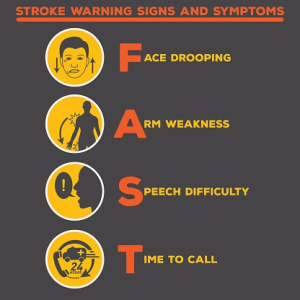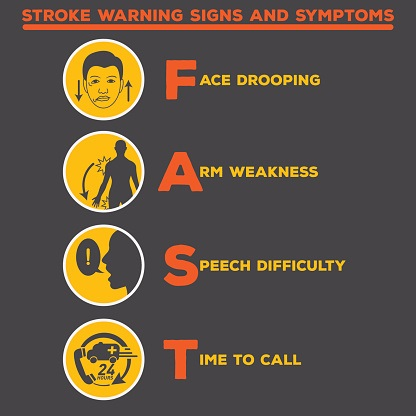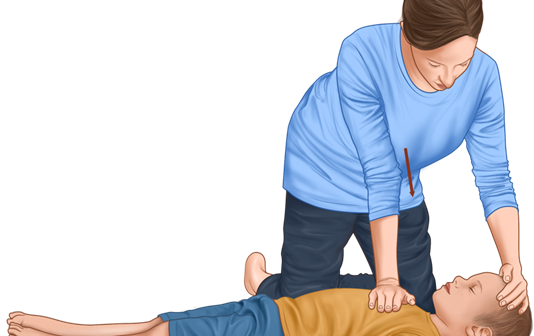Introduction
A stroke is a potentially fatal medical emergency that arises from the disruption of blood supply to a specific area of the brain, resulting in damage or death of brain cells. Anyone can experience it at any time, and if untreated, it can cause permanent impairment or even death. Early detection and timely medical care are critical to reducing the effects of a stroke.

Credit: Jamaica Hospital Newsletter
This article aims to explain typical warning symptoms of stroke and how early intervention can prevent morbidity and mortality.
Stroke Warning Signs
When it comes to stroke management and treatment, time is of the essence. The chances of surviving and recovering increase with the speed at which warning signs are identified and medical attention is sought. The most typical symptoms of a stroke can be easily remembered by using the acronym FAST:
F:
Drooping Face: Is one side of the face numb or drooping? When you ask someone to smile, look for any signs of unevenness or drooping on one side of their face.
A:
Weakness in One Arm: Is one arm numb or weak? Request that they lift both of their arms. Does one arm sag to the side?
S:
Difficulty of Speech: Is speech distorted, slurred, or hard to understand? Request that the individual repeat a short sentence. Are the words ambiguous or illogical?
T:
Time to Call Emergency Help Lines: Every minute matters, Call emergency helplines immediately if you see any of these symptoms, even if they disappear.
Other stroke symptoms
Stroke symptoms that may exist in addition to the FAST indicators include:
- abrupt disorientation or trouble following speech.
- abrupt weakness or numbness in the arm, leg, or face, particularly on one side of the body.
- sudden issues with one or both eyes.
- an abrupt, intense headache without a known reason.
- sudden difficulty standing, lightheadedness, instability, or disarray in gait.
Importance of TIME in Stroke Management
Treatment for a stroke must be started very early to minimize brain damage and avoid long-term problems. A stroke is a medical emergency as up to 2 million brain cells might die for every minute a stroke remains untreated, the expression “time is brain” is very frequently used concerning stroke care.
A stroke can be treated in many ways, although the majority of them work best when started in the first few hours after symptoms appear:
- The administration of clot-busting drugs (for ischaemic strokes) must occur three to four hours after the onset of symptoms to disintegrate clots and restore blood flow to the brain. Another therapeutic option is mechanical thrombectomy, which involves physically removing a clot from a cerebral blood vessel by a specialist.
- Rapid surgery may be necessary for hemorrhagic strokes to seal damaged blood arteries and halt the bleeding.
Stroke Risk Factors
A stroke can happen to anyone, but a few risk factors increase the chance of getting one. These risk factors can be classified as modifiable(controllable) and non-modifiable (uncontrollable). Certain risk factors, like age and heredity, are non-modifiable, others like obesity are modifiable. You can lower your risk of stroke by taking action after becoming aware of your risk factors.
Non-Modifiable Risk Factors
- Age: Stroke risk increases as you age, particularly beyond the age of 55.
- Family history: You may be more vulnerable if a close relative has experienced a stroke.
- Gender: Older women are more likely than men to experience a stroke. For younger women, the risk of stroke can also be increased by pregnancy and birth control pill use.
- Race: Research has shown that compared to other racial groups South Asian, African, and African American heritage are more likely to have a stroke.
Modifiable Risk Factors
- Hypertension: The most common cause of stroke is hypertension or high blood pressure. It’s critical to control blood pressure with food, exercise, and medication.
- Excess alcohol consumption: Consuming alcohol in excess can lead to elevated blood pressure and an elevated risk of stroke.
- Smoking: Using tobacco raises your risk of stroke. That danger is greatly reduced by giving up smoking.
- Diabetes: Due to the harm that high blood sugar levels can do to blood arteries, people with diabetes have an increased risk of stroke.
- High cholesterol: A buildup of plaque in the arteries caused by high cholesterol increases the chance of stroke.
- Obesity and physical inactivity: High blood pressure, diabetes, heart disease, and other stroke risk factors can be brought on by being overweight or inactivity.
Conclusion
Although a stroke can occur abruptly, with early diagnosis and treatment, it need not be fatal. The likelihood of surviving and recovering can be considerably increased by being aware of the warning symptoms and taking prompt action.
You may lower your risk of having a stroke and make sure that you and your loved ones are better prepared in an emergency by being aware of your risk factors and taking preventive action.
Finally, the best preventative action for stroke is getting health coverage that allows you prompt access to doctors’ consultations, laboratory tests, and authentic drugs. WellaHealth Technologies offers you affordable and accessible healthcare plans here, so hurry and subscribe today!






